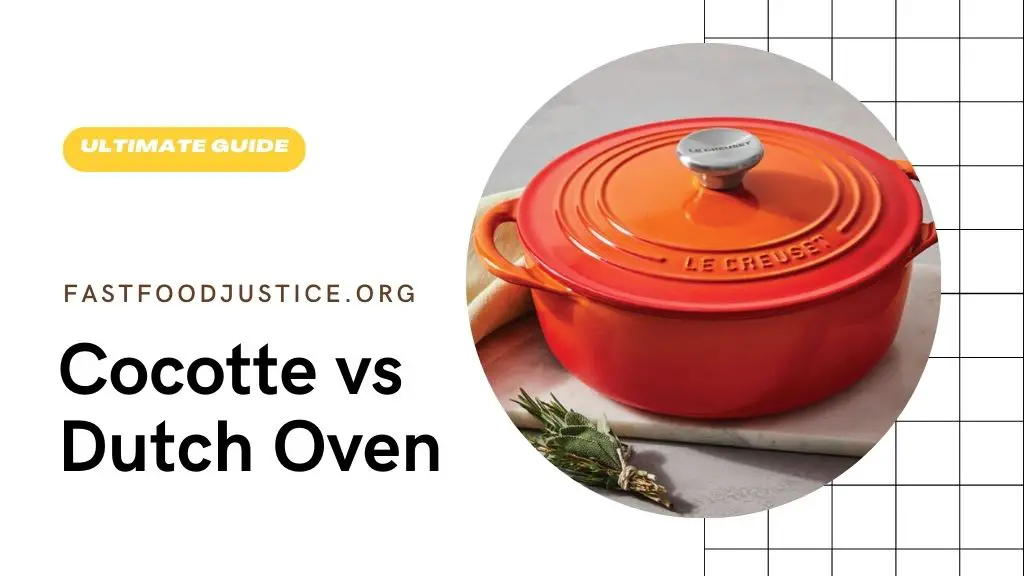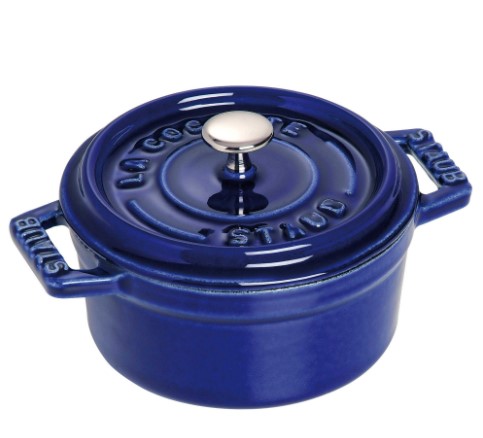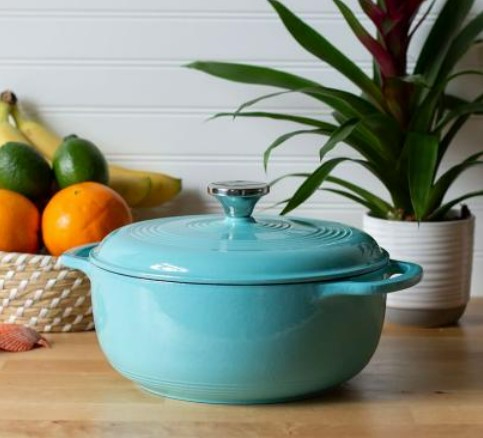Originally posted on July 5, 2023 @ 8:44 am
In the world of culinary arts, the tools you choose can significantly influence the success of your dishes. Among the array of cookware options available, the Cocotte and the Dutch Oven are two prominent choices, each with their unique characteristics. Understanding the distinctions between a Cocotte and a Dutch Oven is crucial for any cooking enthusiast or professional chef.
These pots, while similar in some aspects, also possess significant differences that can affect cooking times, heat distribution and ultimately, the flavors in your food.
By delving into the nuances of these two types of cookware, we can make more informed decisions in the kitchen, leading to better-prepared meals and a more enjoyable cooking experience.

Table of Contents
What is a Cocotte?

A Cocotte, pronounced as co-cot, is a French term for a small cooking vessel, traditionally made from cast iron, with a tight-fitting lid. Derived from the French word for “hen” the term ‘cocotte’ originally referred to the Dutch oven’s chicken-shaped design. This cookware dates back to the 18th century and has been a mainstay in French cooking ever since.
Historically, the Cocotte was first used by French chefs looking for a vessel that could withstand hours of slow cooking over embers without damaging the food’s flavor profile. Today, Cocotte is synonymous with slow-cooked, one-pot French dishes, like cassoulet and coq au vin.
The Cocotte is lauded for its durability, heat retention and ability to evenly distribute heat, making it ideal for slow-cooking methods. Its tight-fitting lid also seals in moisture, ensuring that the food within remains juicy and flavorful.
Additionally, its enamelled cast iron construction not only ensures longevity but also adds an aesthetic appeal, making it suitable for oven-to-table service.
What Is a Cocotte Used For?
A Cocotte’s compact size and unique properties make it a versatile piece of cookware. It’s particularly favored for baking due to its ability to maintain the form of the food being baked. From deep-dish pizzas to pies and cinnamon rolls, the Cocotte can handle an array of baking tasks with ease.
In addition to baking, Cocottes can also be used for frying, boiling, braising, and stewing, much like their Dutch Oven counterparts. Its heat distribution and moisture retention make it ideal for these cooking methods, allowing for an evenly cooked dish with rich flavors and tender textures.
However, where the Cocotte truly shines is in preparing traditional French cuisine. Dishes that require the slow melding of flavors over time, such as cassoulets or coq au vin, benefit immensely from being cooked in a Cocotte.
Its design helps to circulate heat evenly, while the lid locks in moisture and infuses the food with the flavors of its own juices and any added herbs or spices. This results in a meal that is aromatic, full-bodied and deeply satisfying.
What is a Dutch Oven?

A Dutch Oven is a versatile cooking tool, typically made of cast iron or thick cast aluminum, with a tightly fitting lid. It’s well-known for its ability to retain heat, thereby providing even cooking. It’s designed for long, slow cooking, making it ideal for stews, roasts, and other hearty dishes.
The origin of the Dutch Oven dates back to the early 18th century, when an Englishman named Abraham Darby traveled to the Netherlands to observe their advanced methods of casting iron. Inspired, he patented a similar process in England, and the resulting pots were exported back to the Dutch. Hence, the name “Dutch Oven” was coined.
One of the most significant benefits of a Dutch Oven is its versatility. It can be used for baking, roasting, braising, searing, and even frying. In addition to its functionality, it’s also a great way to add style to your kitchen decor – many Dutch Oven designs feature intricate patterns or beautiful enameled finishes.
It’s important to note that the term “Dutch Oven” is often confused with a “Cocotte,” which is similar in size and shape, but made from either ceramic or clay. While the Cocotte can be used for slow-cooking, it’s not as effective at retaining heat as its Dutch Oven counterpart.
Cocotte vs Dutch Oven: Key Differences
Design and structure
When considering the design and structure of a cocotte and a Dutch oven, several key differences stand out.
A cocotte, typically French in design, is often round or oval and has a heavier lid designed to lock in moisture with a tight seal. It’s usually made of enameled cast iron, providing exceptional heat retention and even heat distribution, making it ideal for slow-cooking recipes. It also often touts aesthetics, available in a variety of colors and finishes that make it a visually appealing choice for oven-to-table serving.
On the other hand, a Dutch oven, while also typically constructed from cast iron (enameled or not), tends to have a lighter lid and a broad base. Its design is more utilitarian, primarily focusing on functionality rather than aesthetic appeal. This broad base is advantageous when searing or browning food before slow cooking, as it offers more surface area.
Despite these design differences, both cocottes and Dutch ovens excel in slow cooking and braising, making them indispensable tools in any kitchen.
Materials
The materials used in the construction of both a cocotte and a Dutch oven play a significant role in their function and performance. Enameled cast iron is the most common material found in both these cooking vessels. This type of construction offers excellent heat retention and even heat distribution, making it ideal for slow-cooking methods.
A cocotte, often known for its aesthetics, uses this enameled cast iron to create a durable and attractive finish that comes in a variety of colors. This enamel coating also offers the advantage of preventing the iron from interacting with food and causing changes in flavor.
Dutch ovens, while also frequently made from enameled cast iron, can also be found in bare cast iron variants. Bare cast iron requires seasoning to prevent rust and create a non-stick surface, but it offers the advantage of being able to withstand higher temperatures than its enameled counterpart. This makes the Dutch oven versatile for a variety of cooking methods, from searing meats to baking bread.
The choice between a cocotte and a Dutch oven will largely depend on your specific cooking needs and aesthetic preferences, as both offer excellent cooking performance thanks to their use of cast iron.
Cooking Results
When comparing the cooking results between a cocotte and a Dutch oven, a few nuances come to light. A cocotte’s heavier lid and tight seal make it a stellar choice for dishes that benefit from moisture retention. Soups and stews cooked in a cocotte are known to have enhanced depth of flavor with tender, well-cooked ingredients.
On the other hand, the Dutch oven, with its lighter lid and broader base, excels in tasks such as searing meats or vegetables due to the increased surface area, which promotes even browning. The heat retention quality of the Dutch oven also makes it suitable for baking tasks, delivering perfectly crusted loaves of bread or golden-brown casseroles.
However, despite their differences, both a cocotte and a Dutch oven are capable of producing a wide variety of delicious cooked dishes. The choice, therefore, comes down to the specific cooking method or dish you’re aiming to perfect.
The cocotte and Dutch oven, while different in their nuances, are equally proficient in delivering mouthwatering results every time.
How to Choose Between a Cocotte and a Dutch Oven?
When weighing the pros and cons of a cocotte versus a Dutch oven, several critical factors come into play.
Consider the price
Firstly, you need to consider the price. Dutch ovens are generally more affordable, making them a cost-effective choice. Other, cocottes are a luxury kitchen appliance, often carrying a higher price tag.
Intended usage
Reflect on your intended usage. If you frequently prepare stews, soups or braised dishes, a Dutch oven with its deep design and uniform heat distribution would be a great choice. For those who often bake bread or roast, the shallower and wider cocotte might be a better fit with its superior browning capabilities.
Personal preferences
With personal preferences can also influence your decision. If you value aesthetics in your kitchenware, the chic and stylish design of a cocotte might appeal to you more than the rustic and traditional look of a Dutch oven. However, if you prefer a no-frills, functional piece, a Dutch oven would be the way to go.
Remember, both cocottes and Dutch ovens are versatile kitchen tools and the choice between the two often boils down to your specific cooking style, budget and preferences.
How to Season a Cast Iron Dutch Oven?
To season a Cast Iron Dutch Oven, you’ll need a few simple tools: kitchen gloves, paper towels, a mild dish soap and a bottle of vegetable oil or shortening.
Start by washing the Dutch Oven thoroughly with mild soap to remove any dust or residues.
Dry it completely to prevent rusting.
Next, apply a thin layer of vegetable oil or shortening all over the Dutch Oven, inside and out, using a paper towel.
Preheat your oven to 375°F (190°C) and place the Dutch Oven upside down on the middle rack.
Bake for about an hour.
After an hour, turn off the oven but leave the Dutch Oven inside to cool down gradually.
This process will create a non-stick, rust-resistant coating on your Dutch Oven. Remember, the key to maintaining a well-seasoned Dutch Oven is regular usage and proper cleaning.
Avoid using harsh chemicals or scrubbing too hard, which can strip away the seasoning.
Conclusion
Both the cocotte and the Dutch oven offer exceptional performance in the realm of slow-cooking, braising and baking. The cocotte, with its French origin, often brings an aesthetic appeal, while the Dutch oven, known for its robustness, is a versatile workhorse in the kitchen.
Choice between the two often boils down to personal preference, intended use and budget. Either way, both are excellent investments for the keen home chef.
See also:
Leave a Reply